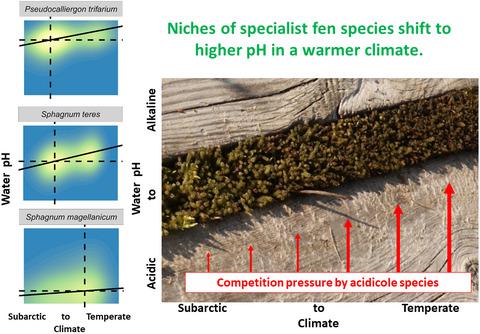当前位置:
X-MOL 学术
›
Glob. Change Biol.
›
论文详情
Our official English website, www.x-mol.net, welcomes your
feedback! (Note: you will need to create a separate account there.)
Rising temperature modulates pH niches of fen species
Global Change Biology ( IF 10.8 ) Pub Date : 2021-11-08 , DOI: 10.1111/gcb.15980 Michal Hájek 1 , Jakub Těšitel 1 , Teemu Tahvanainen 2 , Tomáš Peterka 1 , Borja Jiménez-Alfaro 1, 3 , Florian Jansen 4 , Aaron Pérez-Haase 5, 6 , Emmanuel Garbolino 7 , Michele Carbognani 8 , Tiina H M Kolari 2 , Petra Hájková 1, 9 , Ute Jandt 10, 11 , Liene Aunina 12 , Paweł Pawlikowski 13 , Tatiana Ivchenko 14 , Marcello Tomaselli 8 , Lubomír Tichý 1 , Daniel Dítě 1, 15 , Zuzana Plesková 1 , Eva Mikulášková 1
Global Change Biology ( IF 10.8 ) Pub Date : 2021-11-08 , DOI: 10.1111/gcb.15980 Michal Hájek 1 , Jakub Těšitel 1 , Teemu Tahvanainen 2 , Tomáš Peterka 1 , Borja Jiménez-Alfaro 1, 3 , Florian Jansen 4 , Aaron Pérez-Haase 5, 6 , Emmanuel Garbolino 7 , Michele Carbognani 8 , Tiina H M Kolari 2 , Petra Hájková 1, 9 , Ute Jandt 10, 11 , Liene Aunina 12 , Paweł Pawlikowski 13 , Tatiana Ivchenko 14 , Marcello Tomaselli 8 , Lubomír Tichý 1 , Daniel Dítě 1, 15 , Zuzana Plesková 1 , Eva Mikulášková 1
Affiliation

|
Rising temperatures may endanger fragile ecosystems because their character and key species show different habitat affinities under different climates. This assumption has only been tested in limited geographical scales. In fens, one of the most endangered ecosystems in Europe, broader pH niches have been reported from cold areas and are expected for colder past periods. We used the largest European-scale vegetation database from fens to test the hypothesis that pH interacts with macroclimate temperature in forming realized niches of fen moss and vascular plant species. We calibrated the data set (29,885 plots after heterogeneity-constrained resampling) with temperature, using two macroclimate variables, and with the adjusted pH, a variable combining pH and calcium richness. We modelled temperature, pH and water level niches for one hundred species best characterizing European fens using generalized additive models and tested the interaction between pH and temperature. Fifty-five fen species showed a statistically significant interaction between pH and temperature (adj p ˂ .01). Forty-six of them (84%) showed a positive interaction manifested by a shift or restriction of their niche to higher pH in warmer locations. Nine vascular plants and no moss showed the opposite interaction. Mosses showed significantly greater interaction. We conclude that climate significantly modulates edaphic niches of fen plants, especially bryophytes. This result explains previously reported regional changes in realized pH niches, a current habitat-dependent decline of endangered taxa, and distribution changes in the past. A warmer climate makes growing seasons longer and warmer, increases productivity, and may lower the water level. These effects prolong the duration and intensity of interspecific competition, support highly competitive Sphagnum mosses, and, as such, force niches of specialized fen species towards narrower high-pH ranges. Recent anthropogenic landscape changes pose a severe threat to many fen species and call for mitigation measures to lower competition pressure in their refugia.
中文翻译:

温度升高调节蕨类植物的 pH 生态位
气温上升可能危及脆弱的生态系统,因为它们的特征和关键物种在不同气候下表现出不同的栖息地亲和力。这一假设仅在有限的地理范围内进行了测试。在欧洲最濒危的生态系统之一的沼泽地中,据报道寒冷地区的 pH 值范围更广,预计过去较冷的时期。我们使用欧洲规模最大的蕨类植被数据库来检验 pH 值与大气候温度相互作用以形成已实现的蕨类苔藓和维管植物物种生态位的假设。我们使用两个大气候变量和调整后的 pH 值(一个结合了 pH 值和钙丰富度的变量)对数据集(异质性约束重采样后的 29,885 个图)进行了校准。我们模拟温度,一百种物种的 pH 值和水位生态位使用广义添加剂模型最能表征欧洲蕨类植物,并测试了 pH 值和温度之间的相互作用。55 分物种在 pH 值和温度之间显示出统计学上显着的相互作用(adjp˂.01 )。其中 46 个(84%)表现出积极的相互作用,表现为它们的生态位向温暖地区更高的 pH 值转移或限制。九种维管植物和无苔藓表现出相反的相互作用。苔藓表现出明显更大的相互作用。我们得出结论,气候显着调节了蕨类植物的土壤生态位,尤其是苔藓植物。这一结果解释了先前报道的已实现 pH 生态位的区域变化、当前依赖栖息地的濒危分类群减少以及过去的分布变化。温暖的气候使生长季节更长、更温暖,提高了生产力,并可能降低水位。这些影响延长了种间竞争的持续时间和强度,支持高度竞争的泥炭藓苔藓,因此,迫使特殊蕨类物种的生态位向更窄的高 pH 值范围移动。最近的人为景观变化对许多蕨类物种构成严重威胁,并要求采取缓解措施以降低其避难所的竞争压力。
更新日期:2022-01-05
中文翻译:

温度升高调节蕨类植物的 pH 生态位
气温上升可能危及脆弱的生态系统,因为它们的特征和关键物种在不同气候下表现出不同的栖息地亲和力。这一假设仅在有限的地理范围内进行了测试。在欧洲最濒危的生态系统之一的沼泽地中,据报道寒冷地区的 pH 值范围更广,预计过去较冷的时期。我们使用欧洲规模最大的蕨类植被数据库来检验 pH 值与大气候温度相互作用以形成已实现的蕨类苔藓和维管植物物种生态位的假设。我们使用两个大气候变量和调整后的 pH 值(一个结合了 pH 值和钙丰富度的变量)对数据集(异质性约束重采样后的 29,885 个图)进行了校准。我们模拟温度,一百种物种的 pH 值和水位生态位使用广义添加剂模型最能表征欧洲蕨类植物,并测试了 pH 值和温度之间的相互作用。55 分物种在 pH 值和温度之间显示出统计学上显着的相互作用(adjp˂.01 )。其中 46 个(84%)表现出积极的相互作用,表现为它们的生态位向温暖地区更高的 pH 值转移或限制。九种维管植物和无苔藓表现出相反的相互作用。苔藓表现出明显更大的相互作用。我们得出结论,气候显着调节了蕨类植物的土壤生态位,尤其是苔藓植物。这一结果解释了先前报道的已实现 pH 生态位的区域变化、当前依赖栖息地的濒危分类群减少以及过去的分布变化。温暖的气候使生长季节更长、更温暖,提高了生产力,并可能降低水位。这些影响延长了种间竞争的持续时间和强度,支持高度竞争的泥炭藓苔藓,因此,迫使特殊蕨类物种的生态位向更窄的高 pH 值范围移动。最近的人为景观变化对许多蕨类物种构成严重威胁,并要求采取缓解措施以降低其避难所的竞争压力。











































 京公网安备 11010802027423号
京公网安备 11010802027423号